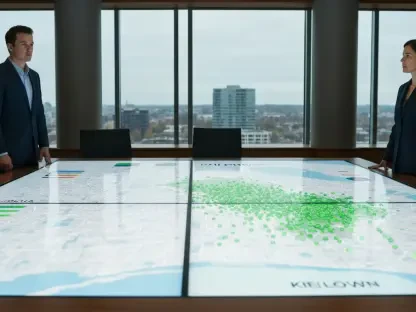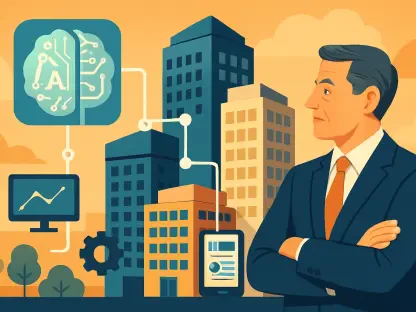Imagine a sprawling metropolis where traffic bottlenecks are predicted and prevented before they snarl commutes, where energy consumption adjusts dynamically to demand, and where infrastructure adapts seamlessly to a growing population. This vision is no longer a distant dream but a tangible reality being shaped by the integration of advanced technology into urban planning. As cities across the globe face mounting pressures from climate change, resource depletion, and rapid urbanization, the need to rethink traditional approaches has become critical. Technology offers a transformative path forward, enabling urban centers to evolve into smarter, more sustainable environments that prioritize efficiency and livability. The shift from outdated, reactive methods to proactive, data-driven strategies is gaining traction, driven by thought leaders who see tech as the cornerstone of future urban resilience. This article explores how innovations are revolutionizing the way cities are designed and managed, addressing complex challenges with precision and foresight.
Revolutionizing Urban Design with Cutting-Edge Tools
The foundation of smarter urban planning lies in technologies that provide unprecedented insight and control over city dynamics. Digital Twins, for instance, create virtual replicas of urban environments, continuously updated with real-time data from sensors embedded throughout a city. This allows planners to simulate scenarios—whether testing the impact of a new transit line or assessing flood risks—without real-world consequences. Such simulations reduce both financial and logistical risks, enabling more informed decision-making. Cities like Singapore have already embraced this tool to optimize mobility and energy systems, demonstrating how digital models can transform abstract plans into concrete outcomes. By mirroring reality in a virtual space, planners gain a sandbox to experiment with solutions, ensuring that every decision is backed by data rather than guesswork.
Complementing Digital Twins, Geographic Information Systems (GIS) offer a detailed lens on spatial relationships within a city. These systems map out everything from zoning patterns to demographic shifts, providing a comprehensive view of urban landscapes. This clarity is invaluable for tasks like optimizing transportation networks or preparing for natural disasters. When integrated with live data feeds, GIS becomes a dynamic tool for real-time monitoring and long-term planning. It helps identify underutilized spaces for development or pinpoint areas most vulnerable to environmental threats. The ability to visualize and analyze such intricate details empowers city officials to craft policies and projects that align with both current needs and future growth, ensuring that urban expansion is both strategic and sustainable.
Creating a Responsive Urban Network
At the heart of a smart city is the ability to react and adapt in real time, a capability driven by the Internet of Things (IoT). This network of interconnected sensors collects data on a myriad of factors—traffic flow, air quality, energy usage—and feeds it into centralized systems for immediate action. Streetlights might dim during low-traffic hours to save power, or waste collection routes can be adjusted based on bin fill levels. This level of responsiveness minimizes waste and maximizes efficiency across urban services. With the rollout of 5G networks enhancing connectivity, IoT infrastructure is becoming more robust, allowing for faster and more reliable data transmission. The result is a city that feels alive, constantly adjusting to the needs of its residents with minimal human intervention.
Tying these systems together is Big Data Analytics, which processes the vast amounts of information generated by IoT and other sources. By uncovering patterns and trends within this data, cities can move beyond reactive fixes to predictive strategies. Congestion can be anticipated and mitigated before it peaks, while public services can be tailored to demand spikes. This evidence-based approach ensures that urban policies are not based on assumptions but on actionable insights. Big Data Analytics serves as the backbone of a connected urban ecosystem, enabling planners to make decisions that are both precise and forward-thinking. As cities generate ever-increasing volumes of data, the role of analytics in transforming raw numbers into meaningful change becomes even more pivotal.
Prioritizing Sustainability and Fairness in Urban Growth
One of the most compelling benefits of tech-driven urban planning is its potential to advance sustainability. Predictive analytics, powered by Artificial Intelligence (AI), can optimize energy grids to reduce waste or improve water distribution to conserve resources. AI also aids in designing infrastructure with minimal environmental impact, such as green buildings or renewable energy hubs. This focus on eco-friendly solutions aligns with global initiatives like the United Nations’ Sustainable Development Goals, which emphasize the creation of sustainable urban communities. By embedding environmental considerations into the planning process, technology ensures that growth does not come at the cost of ecological balance, offering a blueprint for cities that thrive without depleting natural resources.
Equally critical is the need to ensure that technological advancements benefit all segments of society. Urban planning must address equity by using tools like GIS to map out accessible public transit or identify areas for affordable housing development. The risk of widening social divides through uneven tech adoption looms large, making community engagement a vital component of implementation. Solutions must be designed with input from diverse stakeholders to avoid favoring certain groups over others. Addressing the digital divide—ensuring access to technology for underserved populations—is also essential. Only through intentional efforts to promote fairness can cities leverage technology to create inclusive environments where every resident has the opportunity to thrive.
Fostering Partnerships for Urban Innovation
The journey toward smarter cities cannot be undertaken by any single entity; it demands collaboration across multiple sectors. Technology companies bring cutting-edge tools and expertise, while urban planners provide contextual understanding of city-specific challenges. Governments play a crucial role in setting policies and funding initiatives, and academic institutions contribute research and training for the next generation of urban professionals. Such partnerships accelerate the development and deployment of tailored solutions, ensuring that innovations are not just theoretical but practically impactful. Collaborative models also help pool resources, making ambitious projects more feasible even for cities with constrained budgets.
Navigating this collaborative landscape comes with its own set of challenges, particularly around data governance and privacy. As cities become more connected, the volume of personal and operational data collected grows exponentially, raising concerns about security and misuse. Robust frameworks must be established to protect resident information while maintaining transparency in how data is used. Cybersecurity measures are equally important to safeguard urban systems from potential threats. Balancing the drive for innovation with the responsibility to protect public trust is a delicate task, but one that is essential for the long-term success of tech-driven urban planning. Partnerships must prioritize ethical guidelines to ensure that the benefits of connectivity are realized without compromising safety or fairness.
Reflecting on a Path Forward for Smarter Urban Futures
Looking back, the push for technology in urban planning marked a turning point in how cities adapted to modern challenges. Tools like Digital Twins, GIS, AI, IoT, and Big Data Analytics redefined efficiency, enabling urban centers to anticipate issues and respond with precision. Sustainability became more than an ideal—it was woven into the fabric of city growth through data-driven environmental strategies. Partnerships between diverse stakeholders laid the groundwork for innovation, while efforts to ensure equity reminded planners of the human element at the core of every project. The challenges of cost, privacy, and skill gaps were acknowledged and tackled with determination. Moving forward, cities must continue to invest in pilot projects to test and refine these technologies, while fostering public-private collaborations to share the financial burden. Strengthening education in urban tech fields will also be key to building a capable workforce. Ultimately, the legacy of this era will be seen in urban spaces that not only met the needs of their time but also anticipated the demands of generations yet to come, offering a model of resilience and adaptability.









